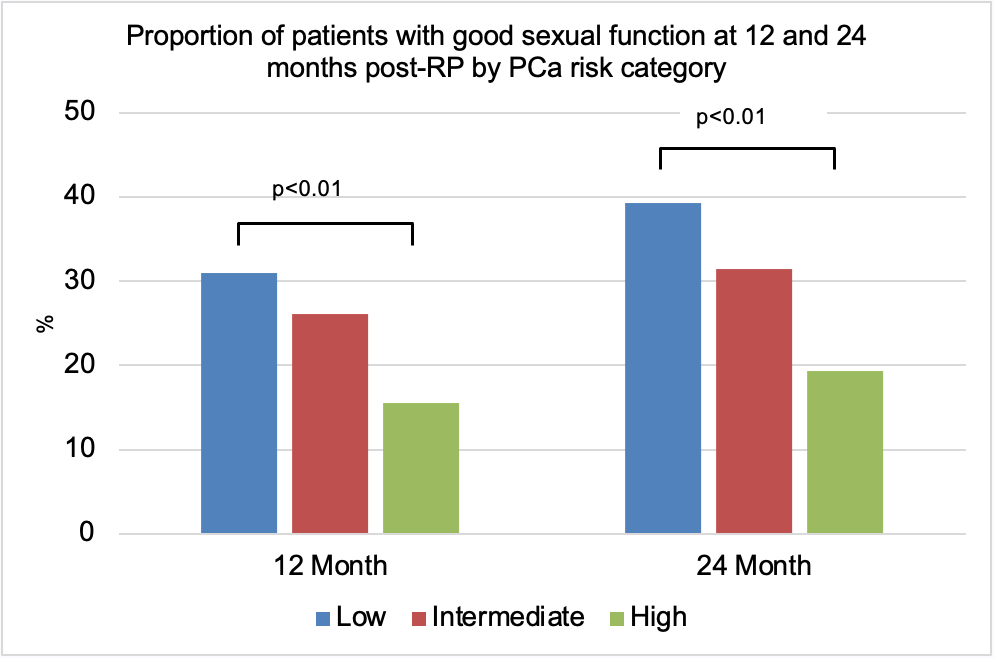Back
Poster, Podium & Video Sessions
Best Poster Award
MP15: Prostate Cancer: Localized: Surgical Therapy I
MP15-18: Rates of social continence and sexual function in high-risk prostate cancer patients: results from a statewide collaborative.
Friday, May 13, 2022
2:45 PM – 4:00 PM
Location: Room 222
Kyle Johnson*, Ji Qi, Stephanie Ferrante, Ann Arbor, MI, Keving Ginsburg, Detroit, MI, Brian Lane, Grand Rapids, MI, Arvin George, Alice Semerjian, for the Michigan Urological Surgery Improvement Collaborative”, Ann Arbor, MI

Kyle T. Johnson, MD
University of Michigan
Poster Presenter(s)
Introduction: To examine the patient reported outcomes (PRO) for patients who underwent radical prostatectomy (RP) for high-risk prostate cancer (HRPCa) within the Michigan Urological Surgery Improvement Collaborative. Sexual function data was reported among patients with good baseline function.
Methods: We collected data for patients with HRPCa at MUSIC practices between 2014-2020. Data abstractors recorded clinical, pathologic, surgical, patient surveys, and follow up data into the registry for HRPCa patients. HRPCa was defined as PSA > 20, Gleason grade group 4 (GG4) or above, and/or clinical stage greater than or equal to cT3a with cancer spreading outside the prostate on at least one side. Patients undergoing RP completed a questionnaire prior to surgery and then at 3, 6, 12, and 24 months after surgery. The questionnaire utilizes the Expanded Prostate Cancer Index Composite (EPIC-26). The study has two primary outcomes: (1) Social continence at 3- and 6-months post-RP, which was defined as 0-1 pad used per day; and (2) Good sexual function at 12- and 24-months post-RP, which was defined as the ability to achieve erections firm enough for intercourse.
Results: A total of 2805 patients diagnosed with HRPCa were identified. At 3 months after RP, 57% of HRPCa patients had social continence, compared to 69% and 66% for low and intermediate risk patients, respectively (p < 0.01). At 6 months 79% HRPCa patients had social continence, 84% for low risk, and 85% for intermediate risk (p < 0.01). At 12 months post-RP 16% HRPCa patients had good sexual function, low risk PCa had 31% and intermediate risk PCa had 26% (p < 0.01). At 24 months post-RP 19% of HRPCa patients had good sexual function, 39% for low risk, and 31% for intermediate risk (p < 0.01).
Conclusions: Post-RP HRPCa patients have significantly lower rates of social continence, but social continence nears low and intermediate risk at 6 months. Sexual function in HRPCa patients is significantly lower compared to low and intermediate risk patients which persists throughout our study period. This information has important implications for pre-operative counseling and post-operative follow-up.
Source of Funding: funding from Blue Cross Blue Shield of Michigan

Methods: We collected data for patients with HRPCa at MUSIC practices between 2014-2020. Data abstractors recorded clinical, pathologic, surgical, patient surveys, and follow up data into the registry for HRPCa patients. HRPCa was defined as PSA > 20, Gleason grade group 4 (GG4) or above, and/or clinical stage greater than or equal to cT3a with cancer spreading outside the prostate on at least one side. Patients undergoing RP completed a questionnaire prior to surgery and then at 3, 6, 12, and 24 months after surgery. The questionnaire utilizes the Expanded Prostate Cancer Index Composite (EPIC-26). The study has two primary outcomes: (1) Social continence at 3- and 6-months post-RP, which was defined as 0-1 pad used per day; and (2) Good sexual function at 12- and 24-months post-RP, which was defined as the ability to achieve erections firm enough for intercourse.
Results: A total of 2805 patients diagnosed with HRPCa were identified. At 3 months after RP, 57% of HRPCa patients had social continence, compared to 69% and 66% for low and intermediate risk patients, respectively (p < 0.01). At 6 months 79% HRPCa patients had social continence, 84% for low risk, and 85% for intermediate risk (p < 0.01). At 12 months post-RP 16% HRPCa patients had good sexual function, low risk PCa had 31% and intermediate risk PCa had 26% (p < 0.01). At 24 months post-RP 19% of HRPCa patients had good sexual function, 39% for low risk, and 31% for intermediate risk (p < 0.01).
Conclusions: Post-RP HRPCa patients have significantly lower rates of social continence, but social continence nears low and intermediate risk at 6 months. Sexual function in HRPCa patients is significantly lower compared to low and intermediate risk patients which persists throughout our study period. This information has important implications for pre-operative counseling and post-operative follow-up.
Source of Funding: funding from Blue Cross Blue Shield of Michigan


.jpg)
.jpg)